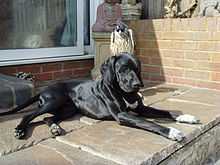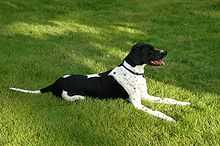Pointer (dog breed)
 | |||||||||||||||||||||||||
| Pointer | |||||||||||||||||||||||||
| Other names | English Pointer | ||||||||||||||||||||||||
|---|---|---|---|---|---|---|---|---|---|---|---|---|---|---|---|---|---|---|---|---|---|---|---|---|---|
| Country of origin | England | ||||||||||||||||||||||||
| |||||||||||||||||||||||||
| |||||||||||||||||||||||||
| Dog (Canis lupus familiaris) | |||||||||||||||||||||||||
The Pointer, often called the English Pointer, is a breed of dog developed as a gun dog. It is one of several pointing breeds.
Description

Appearance
The Pointer traces back from 300 years of English history. It is used to catch rabbits and birds. It should be athletic and graceful. The immediate impression should be of a compact, hard-driving hunting dog, alert and "ready to let go." The primary distinguishing features of this breed are the head, feet, and tail. Hound or terrier characteristics are undesirable for show purposes..
Grooming an English Pointer is not time-consuming. The coat is very short and needs only a quick rub with a soft brush to minimise shedding.
Coat and color
The standard colorings of the Pointer are liver and white, lemon and white, orange and white or black and white. Lemon & white dogs have flesh-colored noses, while orange & white, liver & white, and black & white dogs have dark (black or very dark brown) pigmentation on their noses. They may also be any of the above as solid colors; the body of most Pointers is mainly white, but there may be some body markings.

Size
Most country's breed standards prefer symmetry and balance to perfect size, and most will allow an amount of variation if a dog's size does not encumber it in the field. The approximate measurements in the United States, from the Pointer standard, are as follows:

| Height | Weight | |||
|---|---|---|---|---|
| Males | 60–70 cm | 25–28 in | 25–34 kg | 55–75 lb |
| Females | 58–66 cm | 23–26 in | 20–30 kg | 45–65 lb |
However, the The Kennel Club sizes are female 24–26 in and males 25–27 in.[1]
Temperament
Pointers are even-tempered, congenial dogs, happiest living indoors as part of the family. Pointers are affectionate and loyal. Their aggression level is very low to nonexistent and they can happily coexist with other dogs and cats. They are typically not territorial, although their size and bark will intimidate most people who come to their door. Pointers are very good with children, although young children and a clumsy young Pointer are often not the best combination.
While Pointers were bred to be hunting dogs, they are perfectly content given adequate exercise by other means. Since they are a galloping breed, regular exercise is important for them, as it is for all sporting breeds. A good-sized, securely fenced yard is a must to keep a Pointer safe, since they are bred to hunt a good distance from their person. When left for the day, they typically do best indoors. Pointers are habitual "couch potatoes" who enjoy relaxing on the family's chairs or sofas. This is a natural part of their desire to feel part of the pack.
Health
The Pointer has a median lifespan of 12.4 year in a UK Kennel Club survey.[2] Pointers are fairly genetically sound as a breed. Some problems that can occur in the breed include hip dysplasia, cherry eye, epilepsy, and allergies. Most pointers born in Eastern Australia and New Zealand have had epilepsy bred out of them.
Skills
The pointer is employed to find upland game. In performing its task as a hunters' aid, these skills may be expected from Pointers when hunting:
- Point – The dog finds and points out the location of birds.
- Honor – The dog stops immediately or within a few steps, usually in a pointing stance, upon observing a bracemate on point.
- Retrieve – Pointers are not expected to be natural retrievers, but are often trained and expected to find dead or wounded game.
History
The history of the Pointer, like many breeds, is a reasonably debatable topic.[3] Records of Pointers in England trace as far back as 1650.[3] According to one source, the Pointer came to be in the 16th and 17th centuries, when pointing breeds, including the Spanish pointer, were brought from the European mainland to England.[4]
Through both history and anatomical evaluation, at least four breeds appear to have been instrumental in Pointer crosses: Greyhounds, Foxhounds, Bloodhounds, and Bull Terriers.[3] Each of these were established breeds with unique qualities the Pointer could use to do its job.[3]
Pointers were brought to the United States, where the breed flourished in the abundant open hunting land. At that time (late 1800s), the Setter was considered to be the bird-hunting dog and pointers were not even permitted to compete in field trials with setters. Around 1910, however, the Pointer began to beat the Setter at its own game. The Pointer has dominated the pointing breed field trials since then. (Fergus, 2002).
One of the earliest dogs to exert influence on the breed in the US was a dog imported from England in 1876 – "Sensation". He is well known as the dog on the emblem of the Westminster Kennel Club.
One modern American kennel, established in 1936, and known for breeding large quantities of Pointers, Elhew Kennels produced a popular and successful line of gun dogs. Elhew pointers were well-known competitors at field trials for several decades.
In the southern United States, where the dog is so dominant it is often simply referred to as the "bird dog," Pointers are found in abundance. The bobwhite quail is the primary game bird there, and is considered classic English Pointer game, as the bobwhite will hold well for a pointing dog. Pointers also work game birds such as the pheasant, grouse, and woodcock with success.
Name
While the dog is often called the "English Pointer" colloquially, the official breed name according to the British Kennel Club is simply "Pointer". The same is true of the Fédération Cynologique Internationale, the American Kennel Club, and the Field Dog Stud Book.
Famous pointers
- Judy, awarded the Dickin Medal
- Sensation, featured on the logo of the Westminster Kennel Club[5]
Miscellaneous
The first Pointer was entered at the Westminster Kennel Club Show in 1877. Three Pointers have won "Best in Show" there, the first being Ch. Governor Moscow in 1925, second being Ch. Nancolleth Markable , and the most recent being Ch. Marjetta's National Acclaim in 1986.
References
- ↑ "KC breed standards". The Kennel Club. Retrieved 2011-08-19.
- ↑ "Individual Breed Results for Purebred Dog Health Survey".
- ↑ 3.0 3.1 3.2 3.3 Cavanaugh, Wayne R. Assessing the Show Pointer, Cavanaugh, June 12, 1997.
- ↑ Fergus, Charles. Gun Dog Breeds, A Guide to Spaniels, Retrievers, and Pointing Dogs, The Lyons Press, 2002. ISBN 1-58574-618-5
- ↑ "Sensation, the Westminster Kennel Club's famous Pointer". Westminster Kennel Club. Retrieved 2008-07-14.
External links
| Wikimedia Commons has media related to English Pointer. |
- Pointer breed standard at the official American Kennel Club website
- Pointer on the Open Directory Project
| ||||||||||